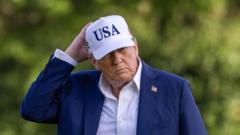The Trump administration's postponement of tariff deadlines has revealed challenges and discontent among global trading partners, igniting a wave of tactical economic responses. With the U.S. trade deficit looming large, other nations pivot towards enhancing their own trade relationships, while tariffs continue to reshape market dynamics.
The Complications of Delayed Tariffs: Global Response to Trump's Trade Strategy

The Complications of Delayed Tariffs: Global Response to Trump's Trade Strategy
As President Trump's tariff plans face postponements, international trade dynamics are shifting, highlighting any gains amidst trade deal frustrations.
Donald Trump's administration has faced significant challenges as it delays the implementation of promised tariffs, originally projected to bring "90 deals in 90 days." The revised deadline, now set for August 1, raises questions about the viability and determination of U.S. trade strategy. With minimal progress anticipated by the initial cut-off date of July 9, the delay underscores a broader struggle to establish meaningful trade agreements.
The approach taken by the Treasury Department focuses on just 18 nations that contribute significantly to America's trade deficit. Recent communications to trading partners echo previous tactics seen in the "Liberation Day" press events from the White House, maintaining the same tariff rates proposed earlier. This indicates potential stagnation in negotiations and an unsettling acknowledgment of difficulties in securing deals.
While financial markets have remained stable amid these delays, skepticism regarding the administration's resolve persists. The reliance on potential delays could lead to renewed tensions in global trade, as nations exhibit resilience in their negotiations with the U.S. Some nations, like Japan and South Korea, have expressed increasing frustration with U.S. tariffs, hinting at leveraging their substantial holdings in U.S. debt as a counter-strategy.
The international landscape remains reactive as the consequences of a fractured global trading system emerge. The dollar's value has dropped by 10% this year against various currencies, contradicting earlier expectations set by the administration, and inflationary pressures continue to rise.
Trade statistics reveal a complicated narrative: Chinese exports to the U.S. have decreased, while their trade with other nations flourishes, particularly in the UK, ASEAN countries, and Africa. This trend suggests that the global market is finding ways around U.S. tariffs, as the latter imposes an effective rate of around 15%, a significant rise compared to historical averages of 2%-4%.
As the U.S. government gathers revenue from tariffs, international economic relationships evolve, fostering new partnerships and trade deals among other nations. The future of U.S. trade relations remains uncertain, as market reactions to tariff changes may evolve unanticipated. The coming months will provide critical insights into how global trade dynamics adapt in the face of U.S. policy shifts.




















